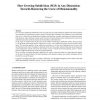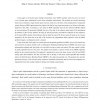27 search results - page 5 / 6 » A combinatorial approach to the analysis of bucket recursive... |
GIS
2006
ACM
13 years 5 months ago
2006
ACM
Geospatial data is often used to predict or recommend movements of robots, people, or animals ("walkers"). Analysis of such systems can be combinatorially explosive. Eac...
FOCS
1997
IEEE
13 years 9 months ago
1997
IEEE
We introduce a new approach to the maximum flow problem. This approach is based on assigning arc lengths based on the residual flow value and the residual arc capacities. Our appro...
CGF
2002
13 years 5 months ago
2002
In recent years subdivision methods have been one of the most successful techniques applied to the multi-resolution representation and visualization of surface meshes. Extension t...
CORR
2010
Springer
13 years 5 months ago
2010
Springer
In this paper we revisit the sparse multiple measurement vector (MMV) problem, where the aim is to recover a set of jointly sparse multichannel vectors from incomplete measurement...
STOC
1996
ACM
13 years 9 months ago
1996
ACM
We significantly improve known time bounds for solving the minimum cut problem on undirected graphs. We use a "semiduality" between minimum cuts and maximum spanning tree...



